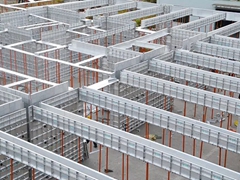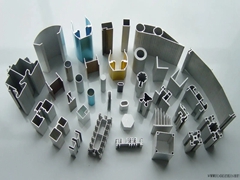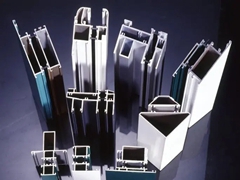What is the effect of the thickness of architectural aluminum profiles?
How is the thickness of architectural aluminum profiles affected? What are the requirements for architectural aluminum profiles when customizing the workbench? The thickness of architectural aluminum profiles generally refers to its wall thickness, which is a very important indicator. One aspect that architectural aluminum profile manufacturers tend to ignore when purchasing architectural aluminum profiles is wall thickness, so what aspects will the thickness of architectural aluminum profiles affect?
1. Meter weight
The wall thickness of architectural aluminum profiles is proportional to the weight in meters. The thicker the wall, the higher the rice weight, and the higher the natural price. The same series of products have different specifications, different wall thicknesses, and different prices.
2. Carrying capacity
In theory, the thicker the wall of building aluminum profiles, the better the load-bearing effect. This is also the misunderstanding caused by most of Wuhan's day and night choices of aluminum profiles. Large equipment frames do need large aluminum profiles, which can not only bear the load well, but also avoid the bending and shaking of the frame during use.
3. Scope of application
The same series of architectural aluminum profiles have different specifications, including light profiles, standard profiles, and heavy profiles. The bearing strength of each profile is different, so the scope of application is also different. Thick aluminum profiles have greater load-bearing strength, while thin aluminum profiles have less load-bearing strength. But that doesn't mean being thin is bad. Each framework requires a different configuration file. Thin aluminium profiles can be used in light frame and fence series. What are the selection skills of architectural aluminum profiles when customizing workbenches?
In terms of the load-bearing capacity of the workbench, if the customized workshop workbench is only equipped with some small processing parts, its load-bearing capacity is not very large, so the use of light or medium profiles, such as 3030 aluminum profiles or 4040 aluminum profiles, can meet the requirements. If some mechanical equipment needs to be placed on a customized workshop workbench, then it is necessary to choose large-sized profiles. Generally, 4545 or 5050 profiles are enough, and the load-bearing can reach about 1200 catties. In short, the larger the cross-sectional profile, the greater its load-carrying capacity and the more expensive it is. Selecting materials according to this standard is enough.
Then there is the connection of accessories. Common accessories for workbenches are corner pieces connected with bolts and nuts. There is also a direct connection with hexagon socket head bolts, which is stronger than the connection strength of corner pieces. If you have loose costs and want high firmness, you can use both. If cost is limited and load capacity is required, use hex socket head cap bolts.
In terms of plates, the commonly used construction aluminum profiles for workbenches can reduce the generation of static electricity and the impact of static electricity on products, which is especially suitable for electronics factories. If there are no special requirements, stainless steel panels, composite panels, etc. Can also be selected as a panel.
We are a manufacturer of architectural aluminum profiles, if you want to know more about this, you can contact us. We can introduce it to you.
1. Meter weight
The wall thickness of architectural aluminum profiles is proportional to the weight in meters. The thicker the wall, the higher the rice weight, and the higher the natural price. The same series of products have different specifications, different wall thicknesses, and different prices.
2. Carrying capacity
In theory, the thicker the wall of building aluminum profiles, the better the load-bearing effect. This is also the misunderstanding caused by most of Wuhan's day and night choices of aluminum profiles. Large equipment frames do need large aluminum profiles, which can not only bear the load well, but also avoid the bending and shaking of the frame during use.
3. Scope of application
The same series of architectural aluminum profiles have different specifications, including light profiles, standard profiles, and heavy profiles. The bearing strength of each profile is different, so the scope of application is also different. Thick aluminum profiles have greater load-bearing strength, while thin aluminum profiles have less load-bearing strength. But that doesn't mean being thin is bad. Each framework requires a different configuration file. Thin aluminium profiles can be used in light frame and fence series. What are the selection skills of architectural aluminum profiles when customizing workbenches?
In terms of the load-bearing capacity of the workbench, if the customized workshop workbench is only equipped with some small processing parts, its load-bearing capacity is not very large, so the use of light or medium profiles, such as 3030 aluminum profiles or 4040 aluminum profiles, can meet the requirements. If some mechanical equipment needs to be placed on a customized workshop workbench, then it is necessary to choose large-sized profiles. Generally, 4545 or 5050 profiles are enough, and the load-bearing can reach about 1200 catties. In short, the larger the cross-sectional profile, the greater its load-carrying capacity and the more expensive it is. Selecting materials according to this standard is enough.
Then there is the connection of accessories. Common accessories for workbenches are corner pieces connected with bolts and nuts. There is also a direct connection with hexagon socket head bolts, which is stronger than the connection strength of corner pieces. If you have loose costs and want high firmness, you can use both. If cost is limited and load capacity is required, use hex socket head cap bolts.
In terms of plates, the commonly used construction aluminum profiles for workbenches can reduce the generation of static electricity and the impact of static electricity on products, which is especially suitable for electronics factories. If there are no special requirements, stainless steel panels, composite panels, etc. Can also be selected as a panel.
We are a manufacturer of architectural aluminum profiles, if you want to know more about this, you can contact us. We can introduce it to you.





Leave a comment